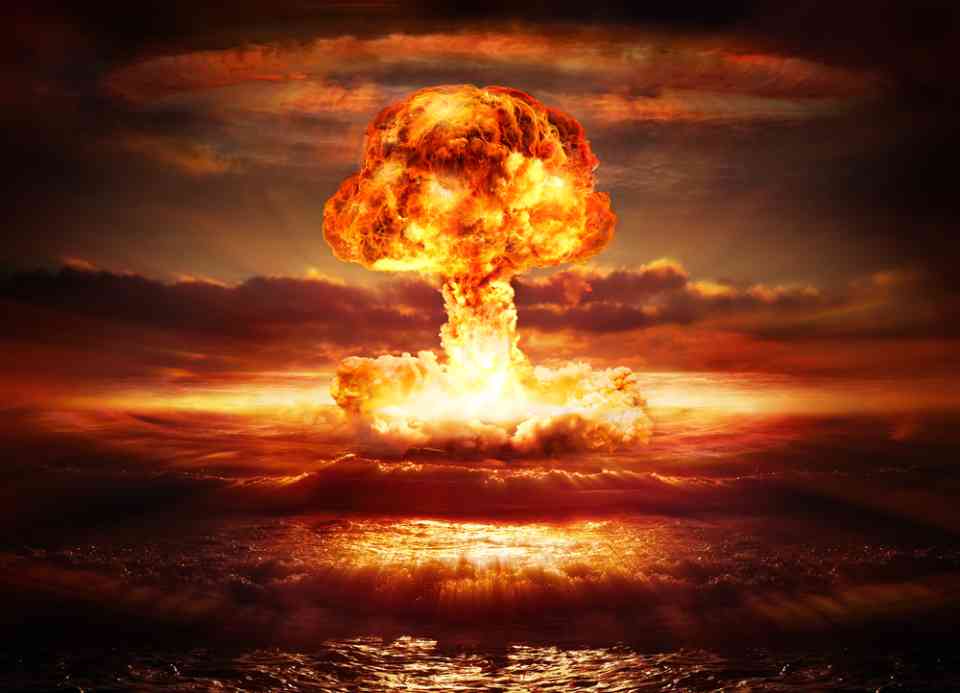Ranked: Deadliest Weapons Ever Created

Throughout the course of human history, conflicts driven by territorial disputes, resource acquisition, and ideological differences have sparked the search for military advantage. This pursuit has resulted in the invention of increasingly deadly weapons, often with the assistance of rapidly advancing technologies.
The inhumane aspect of such inventions lies in the fact that they often disregard the horrifying consequences of these new weapons on humanity. As a result, military technology has evolved over millennia, yielding instruments of destruction with frightening success. In fact, many modern weapons leverage the power of terror itself — exploiting the psychological impact on enemies — to achieve victory.
To identify history’s most lethal weapons, CEOWORLD magazine reviewed a report called “Quantification Related to Weapon Lethality,” which was originally issued in 1964 by the Historical Evaluation and Research Organization for the US Army Combat Developments Command. The report rates the lethal potential of various weapons on quantifiable measures such as the number of potential targets per strike, relative effect, effective range, accuracy, reliability, and mobility. It is important to keep in mind that this list is not exhaustive and only represents a sample of some of the deadliest weapons. For instance, there are other highly lethal nuclear weapons besides those listed here.
Some entries on this list highlight the rapid technological evolution since the Industrial Revolution. The sword, for instance, is a tool used across cultures and eras, which retains ceremonial significance in military contexts. On the contrary, the weapons employed in World War I were rendered obsolete at the onset of World War II.
The progression of military technology often originates from scientific advancements in unrelated fields. For instance, the airplane, initially conceived as a rapid mode of transportation, swiftly found application in warfare. This relationship is reciprocal – gunpowder, employed in Chinese warfare as early as the 10th century, serves not only as a tool for destruction but also as a means to excavate tunnels and provide entertainment through fireworks.
- 25-megaton hydrogen bomb
> Lethality index score: 210,000,000,000
Created in the manic arms race of the Cold War, the B-41 hydrogen bomb is the deadliest weapon on this list. The bomb is capable of destruction on a colossal scale. However, the good news is that it has never been used in warfare. Its 25-megaton payload is equivalent to 25 million tons of TNT and is more powerful than Fat Man’s 20 kilotons of destructive potential. The bomb entered the US military service in 1961 and was withdrawn in 1976.
- 20-kiloton nuclear bomb (Fat Man)
> Lethality index score: 48,550,000
The atomic bomb nicknamed “Fat Man” brought Armageddon to Nagasaki, Japan, at the end of World War II. More powerful than the bomb dropped on Hiroshima three days earlier, it destroyed Nagasaki in a split second, killing tens of thousands instantly and leaving many more seriously wounded by the blast and sickened by nuclear fallout. The explosion led to unconditional surrender by the Japanese. It was for the second time a nuclear bomb had been used in a war.
- World War II fighter-bomber
> Lethality index score: 3,037,900
Along with tanks, aircraft technology advanced significantly in the interwar period. Most militaries adopted single-wing aircraft and air power, thereby became another staple of combat. Fighter bombers were capable of shooting down other planes as well as devastating ground targets. Advances in weapons and aviation technology meant that these planes had significantly larger ranges, more firepower, and more advanced tactical abilities.
- World War II tank (Sherman M4)
> Lethality index score: 2,203,000
Tank technology advanced rapidly during the interwar period. In World War II, they were a crucial part of combat. Nazi forces seized massive expanses of territory with rapid tank advances known as blitzkriegs — literally “lightening wars.” Their ability to move quickly while being armored and carrying massive firepower shocked several armies into submission in the early days of the war. However, as tank technology advanced, so did anti-tank weapons, proving that the vehicles were not invincible.
- Automatic grenade launcher
> Lethality index score: 1,500,000
Automatic grenade launchers are usually mounted on vehicles or helicopters and are able to rapidly fire grenades to devastating effect. The US first introduced its M19 automatic grenade launcher in 1966 and used it throughout the Vietnam War. The weapons are used for direct fire on targets and for indirect fire like mortars. With the advancement of technology, some launchers now fire smart grenades that explode at certain points in the air.
- V-2 ballistic missile
> Lethality index score: 861,000
The world’s first long-range ballistic missile, the V-2, was created by the Nazis to retaliate against Allied forces for bombing German cities during World War II. Together with V-1s its cruise missile predecessors, the V-2 rained down on British cities in 1944 and ’45. There was no way to defend against them and very little warning before they arrived. After the defeat of the Nazis, the Americans and Soviets jostled to acquire V-2 technology and the scientists that had invented the missiles.
- French 75mm gun
> Lethality index score: 340,000
Commonly known as the French 75, the cannon was originally designed to fire anti-personnel shrapnel shells, but later, it was adapted to also use high-explosive shells and toxic gas shells. It was first adopted by French forces in 1898 and was proof of huge advancement in technology. New aiming and loading technology meant the cannon could fire significantly faster than other similar contemporaneous weapons. What’s more, the gun did not shift after firing, so artillery crews were not forced to re-align it after every shot. It saw extensive usage in World War I and some in World War II.
- World War I fighter-bomber
> Lethality index score: 229,200
It was during World War I that airplanes, for the first time saw widespread action in combat. Fight-bombers were equipped with machine guns to take down enemy aircraft and a limited number of bombs to drop on targets. Although bombing accuracy was poor at the time, a successful hit could devastate exposed enemy troops. Moreover, pilots suffered high numbers of casualties, and flying was still very dangerous even when not in combat.
- World War I tank
> Lethality index score: 68,300
Tanks were originally invented to break the deadlock of World War I trench warfare. These heavily armored vehicles used treads instead of wheels and were armed with machine guns and naval cannons. Winston Churchill is regarded as one of the patrons of the development of tanks to turn the tide of the war.
- World War I machine gun
> Lethality index score: 12,730
Machine guns saw widespread use in World War I with devastating effects. In spite of several drawbacks of machine guns at the time, like their heavy weight, several people required to operate, and likely to get overheated, they, nevertheless, unleashed carnage on the battlefield like the world had never seen before. In many ways, the weapons of the time were ahead of the tactics. For instance, commanders often foolishly sent soldiers and cavalry to charge in, only to see them mowed down by these rapid-fire weapons.
- Assault rifle
> Lethality index score: 4,200
The first assault rifle was German-made and saw widespread implementation for the first time during World War II. Assault rifles have detachable magazines for rapid reloading and several different rates of fire. ARs are the most popular weapon among soldiers in the modern world and have improved considerably since their first conception. The Soviet AK-47 and American M16 are two of the most iconic assault rifles.
- Springfield 1903 sniper rifle
> Lethality index score: 778
The Springfield 1903 is a five-round magazine bolt-action rifle. The US military adopted it around the beginning of the 20th century and saw action during World War I and, to some extent, in World War II, though it was obsolete at that point. It was a deadly, accurate weapon that could be fired and reloaded rapidly.
- Breech-loading rifle
> Lethality index score: 229
Breech-loading firearms took off in the 19th century with the advancement of the precision machinery needed to make them effective. These firearms are loaded from the rear instead of the front of the gun – a method that is much faster and safer and used in almost all modern weapons. Their rifling, in combination with the spiraling (of the inside of the barrel) for accuracy, made breech-loading rifles far more lethal and effective than muskets.
- Flintlock musket
> Lethality index score: 47
Flintlocks are front-loading firearms that use flint to ignite gunpowder. It replaced guns with other firing mechanisms in the 17th century. Though not the most accurate, flintlocks, nevertheless, could be effective if fired in large numbers. The weapon remained popular until midway through the 19th century.
- 16th-century cannon
> Lethality index score: 43
The rise of cannons changed warfare on land and sea. Fortifications were forced to adapt to siege from cannon fire and, in turn, arm themselves with these powerful weapons. Cannons during this time period were often difficult to maneuver as they were not very accurate. However, they did massive damage if they found their mark.
- Crossbow
> Lethality index score: 32
First seen in East Asia, crossbows applied many of the principles of bows while allowing users to harness more power and accuracy. They were easier to operate than conventional bows, so it took considerably less training to be used effectively.
- Sword
> Lethality index score: 20
Swords were the most ubiquitous and iconic pre-gunpowder weapons that have come in countless different forms and styles around the world. An evolution of daggers, early swords date back at least to around 3300 BC, at the beginning of the Bronze Age. They remained in military service even long after the invention of firearms and are still widely used ceremonially.
- Arquebus
> Lethality index score: 10
The arquebus was an early firearm that appeared in the 15th century in Europe. Originally used as a defensive weapon for protecting cities and other fortifications, the arquebus had several drawbacks – it was slow to reload, inaccurate, and too heavy, so much so that it had to be mounted on a pole to be fired. There is a potent French spirit called Arquebuse de l’Hermitage, which legend has it was first formulated to treat those wounded by an arquebus.
Have you read?
Character – The Aerodynamics of Leadership.
The Rise of the Inter-Generational CEO: Working with Gen Z eye to eye.
A New Approach to Public Sector Decision Making.
How a CEO Can Best Handle a Crisis.
Redefining Thankfulness: Gratitude Examples for the Forward-Thinking Leader.
Financial Services, Risk Management and Beyond — Tech Entrepreneur, Henna Karna’s Vision for the Future.
Bring the best of the CEOWORLD magazine's global journalism to audiences in the United States and around the world. - Add CEOWORLD magazine to your Google News feed.
Follow CEOWORLD magazine headlines on: Google News, LinkedIn, Twitter, and Facebook.
Copyright 2025 The CEOWORLD magazine. All rights reserved. This material (and any extract from it) must not be copied, redistributed or placed on any website, without CEOWORLD magazine' prior written consent. For media queries, please contact: info@ceoworld.biz








